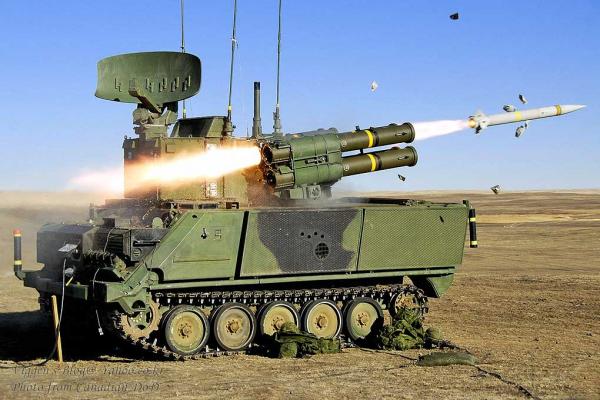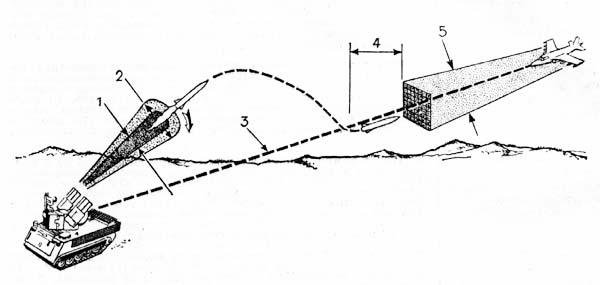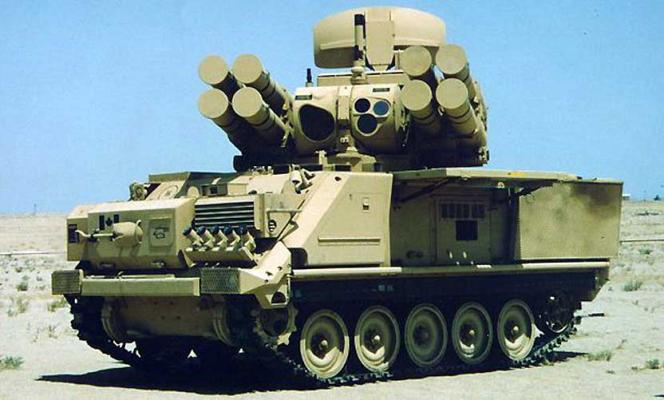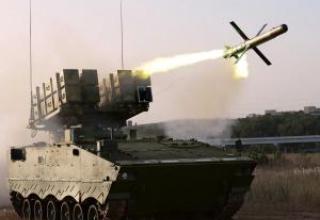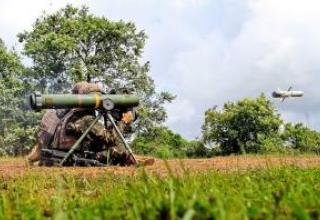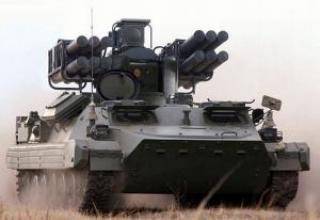The development of the multi-purpose missile system ADATS (Air Defense Anti Tank System), capable of engaging both air and ground targets, was completed by the Swiss company Oerlikon Contraves in 1984 together with the American Martin Marietta.
The complex is designed to combat high-speed low-flying aircraft, helicopters, unmanned reconnaissance assets, as well as ground armored targets. It can be used to defend both mobile and stationary targets.
In April 1986, a contract was signed for the production and supply to the Canadian Armed Forces (between 1988 and 1989) 36 multi-purpose missile systems ADATS and 800 missiles to them. The USA, the Netherlands, Belgium, Turkey and a number of other countries are also considered as potential buyers of this complex.
In 1987, it became one of 4 air defense systems that took part and was recognized as a winner in a competition organized by the Air Defense Command of the U.S. Forces of Advanced Grounding. The competition included an assessment of the accuracy of the detection and tracking of targets performing a typical raid scenario. However, only eight ADATS systems were accepted for U.S. service for financial reasons.
Composition:
The ADATS missile system is a part of it:
- eight missiles in transport and launch containers,
- Radar detection of air targets,
- electron-optical module for tracking targets and pointing missiles at them,
- Computer and other necessary equipment.
The battle count is three people: the commander, the operator and the mechanic-driver. The modular design of the complex allows its installation on tracked or wheeled machines of various types.
ADATS guided by laser beam missile is made according to the normal aerodynamic scheme, has a solid fuel engine with two modes of operation. Due to its high maximum flight speed (M = 3), it is capable of engaging moving targets visible within a short period of time at relatively long ranges. The missile uses a cumulated shrapnel warhead capable of penetrating armor up to 900 mm thick. There are two types of fuzes; the non-contact one is used when firing at air targets and the contact one is used when firing at ground armored targets. The recharging time of all missiles without the use of special devices by two members of the combat unit is less than 10 minutes.
Pulse Doppler Radar is an improved version of the LPD-20 radar developed by the Italian branch of Oerlikon Contraves. The station can operate on the spot and in motion, can detect aircraft and helicopters at ranges up to 24 km, flying at altitudes up to 6 km. Depending on the terrain, it can detect ground armored targets at ranges of up to 6 km. The radar transmitter, operating in the 5.2 - 10.9 GHz wavelength range, is made on a running wave lamp and has a fast frequency adjustment. The processor provides simultaneous tracking of up to six targets. The radar is combined with a system of identification "your - someone else's" and gives the screen round view of the target coordinates (azimuth and range) and its accessory. In the early 80's in the U.S. at the Aberdeen Test Site conducted assessment tests of the station to detect helicopters at ranges of 5-18 km at an angle of the antenna pattern of direction from 0 to 1 °. It was reported that the UH-1H Iroquois helicopter, flying at low altitudes, was detected by radar in the range of 11-16 km with a probability of 0.9. Both types of tracking devices have wide and narrow fields of view (television - 4° and 0.9°, thermal imaging - 9° and 3.2°) and can be used for tracking both air and ground targets. The television device with high resolution is used in daylight at favorable weather conditions, and the thermal imaging device (wavelength range 8-12 microns), developed on the basis of the night vision system of the AH-64A "Apache" helicopter, - when tracking air targets not only in the dark but also in difficult weather conditions.
The electron-optical tracking module is mounted on a rotating tower between two missile assemblies. It has a gyrostabilized platform on which a thermal imaging device, a television camera, a laser guidance system for rockets (in a coded beam), a laser rangefinder on a crystal of a nitrium-aluminum grenade with a mixture of neodymium, infrared goniometers designed to determine the coordinates of the missile while the engine is running. The module allows you to accompany the target at an angle of -1° to +90 ° at any azimuth.
Infrared and television (passive) tracking devices were chosen due to the fact that they have a small mass, small size, have a high noise immunity from the means of REB and good characteristics when accompanied by ground and low-flying air targets, reduce the probability of hitting the complex by self-guided anti-radar missiles. Both types of tracking devices have wide and narrow field of view (television - 4° and 0.9°, thermal - 9° and 3.2°) and can be used for tracking both air and ground targets. The television device, which has a high resolution, is used in daylight at favorable weather conditions, and thermal infrared (wavelength range 8-12 microns), developed by the U.S. firm "Martin Marietta" based on the night vision system of the combat helicopter AH-64A "Apache" - with the air targets not only in the dark but also in difficult weather conditions.
The television device used in the ADATS complex has a higher resolution than infrared and is usually used as the main ground target tracking device. Its optical channels are combined with a laser rangefinder. Passive tracking devices can also be used to detect air and ground targets, when it is necessary to increase the stealth of the combat application of the complex or in conditions of strong radio resistance of the enemy.
The ADATS complex on the M113M2 chassis is airborne by C-130 Hercules aircraft. During numerous tests, which took place in different climatic conditions (from -40°C to +70°C), the ADATS system showed stable operation.
ADATS complex can be integrated with other armored chassis or fixed air defense systems. One of the last such example is integration of ADATS complex with MO WAG Piranha chassis (wheel arrangement 10x10) in 1995. This version of the complex is designed for air defense of airfields, power plants and other important objects. It is planned to use the ADATS complex in the sea-based variant as an independent air defense system, as well as integrated with other types of anti-aircraft weapons.
The ADATS complex can be combined into a network structure consisting of six complexes using the C3 system (Command, Control and Communication). A single tactical node is formed, in which communication is carried out using one of the 2000 closed frequencies. This tactical node allows ADATS complexes to communicate with other radars and weapon systems, as well as with similar tactical nodes. One of the six ADATS complexes is considered the main one, and its commander receives full information about the location coordinates of each complex, as well as the current tactical situation. In addition, the tactical node includes one or more observation radars that provide radar information to all complexes. The commander of the tactical node directs the combat work of the complexes, gives them combat orders for weapons management and makes the target allocation to each complex through the appropriate channels of communication.
Characteristics:
| Range, km | |
| minimum | 0.5 |
| airborne | 8 |
| land-based maximum | 6 |
| Accessibility by height, km | 5 |
| Maximum missile flight speed | 3M (1000m/s) |
| Rocket length, mm | 2050 |
| Rocket body diameter, mm | 152 |
| Wingspan, mm | 360 |
| Start weight , kg | 51 |
| Weight of combat unit, kg | 12 |
| Armor-piermeable, mm | 900 |
Testing:
On 28 June 2000 (or 2008, which is more likely), 25 Grad-M multiple launch rocket systems were delivered to Georgia via the delivery channel from the settlement of Oktyabrsky to the settlement of Batumi by the ship "Evgenia N". The firm-supplier is SC "Ukrspetseksport".
Sources:
- В. Викторов "Многоцелвой ракетный комплекс", Иностранное военное обозрение N2, 1987г.
